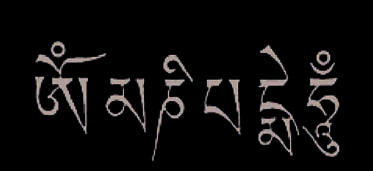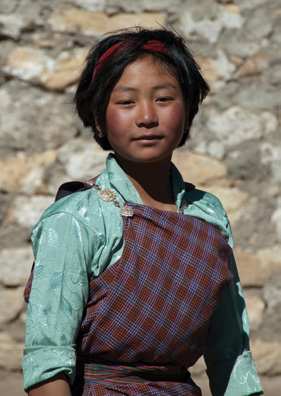An Illustrated Outline of Buddhism: The Essentials of Buddhist Spirituality (30 page)
Read An Illustrated Outline of Buddhism: The Essentials of Buddhist Spirituality Online
Authors: William Stoddart,Joseph A. Fitzgerald
Tags: #Philosophy

96
An Illustrated Outline of Buddhism
Green Tārā, Mongolia, early 18th century



Tibet
97
the emptying of the mind of worldly things, invocation is the filling
of the mind (and heart) with a revealed Divine Name and its saving
grace.
The masculine and feminine principles of
tantra
are present in the
Names contained in the
Mani-Mantra
,
the central invocatory prayer
of Tibetan Buddhism, namely,
Om Mani Padme Hum
: “O
Thou Jewel
in the Lotus, hail.” The Jewel may be interpreted as Avalokiteshvara
(the Bodhisattva representing the Buddha’s Mercy or Compassion)
and the Lotus as his feminine counterpart Tārā. The Lotus (
padma
)
is
the existential or “horizontal” support for the “vertical” or “axial”
Jewel (
mani
).
The Lotus is thus the symbol of the pure and humble human soul
(viewed as feminine and “horizontal”) that opens out its petals (i.e.
acquires the fundamental spiritual virtues) so that it may attract, and
become the fitting vehicle of, the Jewel of Buddheic grace (viewed as
masculine and “vertical”). This symbolism is identical to that of weav-
ing, in which the weft (horizontal) and the warp (vertical) are in the
same “sexual” relationship to one another. “Weaving” is in fact the lit-
eral meaning of the word
tantra
.
There is an obvious analogy between the Tibetan formula and sim-
ilar invocatory prayers in other religions, such as
Sītā-Rām
in Hindu-
ism and
Jesu-Maria
in Catholicism.
As indicated in the table on the preceding page, the union of the
“Subject” with the “Object”, of the Invoker with the Invoked, of the
Lover (masculine) with the Beloved (feminine) results in
Ānanda
or
“Bliss”. In Buddhist
tantra
this spiritual union is called
Mahāsukha
(“the Great Bliss”). This is symbolized in Tibetan art by the tantric stat-
ue of
Yab-Yum
(literal y “father-mother”), which portrays the loving
union of the masculine and the feminine principles.
The
mantra
Om Mani Padme Hum
(“O Thou Jewel in the Lotus, hail!”)


98
An Illustrated Outline of Buddhism
His Holiness the 13th Dalai Lama,
lama tulku
of Avalokiteshvara
Take heed of the lives of the saints, the law of karma, the miseries
of worldly existence . . . , the certainty of death, and the uncer-
tainty of the time of death. Weigh these things in your minds,
and devote yourselves to the study and practice of Remembrance.
Milarepa3
3 In the above quotation, Remembrance means “remembrance of the Buddha”
(
Buddhānusmriti
) through the way of invocatory prayer (
mantrayāna
).


Tibet
99
iv. The Panchen Lama and the Dalai Lama
In order to understand the roles of the Panchen Lama and the Dalai
Lama, it is necessary to take into account the “celestial principles” (i.e.,
the Buddha or Bodhisattva) which they represent. These are respec-
tively Amitābha Buddha and Avalokiteshvara. (See the tables on pp.
72-73.)
Amitābha Buddha is the Buddha (or Aspect of the one and uni-
versal Buddha) who presides over the “Western Paradise” (i.e. the state
entered by those who achieve salvation through the invocation of the
Name of Amitābha).
Avalokiteshvara (known as “Chenrezig” in Tibetan) is the Bodhi-
sattva who represents one of the main qualities of Amitābha, namely
Mercy or Compassion. Avalokiteshvara is said to emerge from the
forehead of Amitābha.
A
lama tulku
is
a human being who has the function of incar-
nating a “celestial principle”. (The various
lama tulku
s
are sometimes,
perhaps misleadingly, referred to as “Living Buddhas”.) The Panchen
Lama, whose traditional residence is in Shigatse, is the
lama tulku
who
incarnates Amitābha (the Buddha of the “Western Paradise”). The Da-
lai Lama, whose traditional residence is in Lhasa, is the
lama tulku
who
incarnates Avalokiteshvara (the Bodhisattva of Mercy or Compassion).
Since Avalokiteshvara is hierarchical y inferior to Amitābha, the
Dalai Lama is hierarchical y inferior to the Panchen Lama. But this
does not detract from the importance in practice of the Dalai Lama,
who has the specific function of “Protector of Tibet”. He fulfil s this
function, not merely by being both temporal ruler and supreme reli-
gious authority, but also by exercising what is known in the Buddhist
world as an “activity of presence”. As
lama tulku
of
Avalokiteshvara
or Chenrezig (the Bodhisattva of Compassion), the Dalai Lama is the
incarnation of this “celestial principle”, and through him, it radiates,
protectively, over the Tibetan people and their religion. It is this “activ-
ity of
presence” that is the essential role of the Dalai Lama.
The office of
lama tulku
of Chenrezig is transmitted from one Da-
lai Lama to the next by means of a certain traditional process which is
described by Heinrich Harrer in his book
Seven Years in Tibet
.
If the Dalai Lama possesses the providential function of Protector
of Tibet, it may be asked why it was possible for him to be displaced
from office, expelled from Tibet, and for his country and religion to
have been ravaged by the Chinese communists. The answer to this is


